Abstract
Although the Müller-Lyer, Poggendorff and Zöllner figures and the illusions with which they are associated– those of length, misalignment and non-parallelism, respectively – are quite different, all three are attributable to the same basic effect, that of the difference in the apparent length of equal lines forming acute and obtuse angles. The role of this basic affect, reported originally by Müller-Lyer but overlooked by him and others as a possible cause of the three illusions, is identified and discussed. It is suggested that the demonstration of a basic stimulus condition (acute and obtuse angles) and its associated illusion (difference in apparent length) generating a class of “higher order” geometric illusions has implications not only for a closer understanding of the three illusions under consideration but for other classes of illusory phenomena that might also share a common basis.

Keywords:
When, according to Edwin G. Boring (Citation1942), Johann Karl Friederich Zöllner (Citation1860) sent his paper on an illusion of apparently converging and diverging parallel lines () to Johann Christian Poggendorff, editor of the recently established Annalen der Physik, the latter pointed out that there was another illusion in the stimulus array: collinear lines intersecting parallels at an oblique angle appear to be misaligned (). Thus there were two illusions in the same figure, one of converging parallels and the other of misaligned collinear lines. To honour the editor's discovery Zöllner named the misalignment effect the Poggendorff illusion. His own discovery of converging parallels has since been referred to as the Zöllner illusion. Some 30 years later, Franz Carl Müller-Lyer (Citation1889) reported in the Archiv der Physiologie his now widely known illusion of lines of equal length appearing to be unequal when they terminate in inward- or outward-directed angles ().
Figure 1. Conventional versions of (a) the Müller-Lyer illusion of unequal lengths; (b) the Poggendorff illusion of misalignment; and (c) the Zöllner illusion of converging and diverging parallels
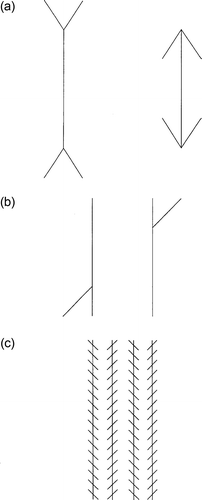
All three illusions have been extensively and intensively investigated in their own right but so far have not been satisfactorily explained and, after well over a century, attempts to do so continue to appear in the research literature. More to the point of what follows, the three illusions along with various others have by and large been treated as different effects, each requiring a different explanation. The primary purpose of this paper was to draw attention to a common stimulus condition that suggests a plausible and testable explanation of all three effects. It is proposed that the illusion of length in the Müller-Lyer figure, of misalignment in the Poggendorff figure and of convergence and divergence in the Zöllner figure are essentially the same in that they all derive from a common feature of the stimulus figure. That is, although the three illusions appear to be unalike they derive from the same basic property of the stimulus. There is an analogy in this proposal – but only an analogy – with the genetic notions of genotype and phenotype: although things look different they are fundamentally the same. In these terms the common condition gives rise to a broad class of geometrical illusions in which the common condition is expressed in superficially different formations.
In what follows attention is drawn to relevant features of the three illusory figures followed by identification in each of the common stimulus condition. In the third section attention is drawn to the same stimulus feature in other geometric figures including those reported originally by Hering (Citation1861), Wundt (Citation1898) and Orbison (Citation1939). In a concluding demonstration it is shown that the actual point of intersection between the three lines forming figures like those in the Müller-Lyer (Citation1889) original figure is a critical determinant of a class of illusions.
Müller-Lyer, Poggendorff and Zöllner illusions
Müller-Lyer's original figure (his ) consisting of an acute and an obtuse angle in which all the lines are the same length is shown in . As can be seen, both lines forming the acute angle appear shorter than both those forming the obtuse angle. shows that this illusion of unequal lengths persists when the two angles are merged so that they share the same oblique line and furthermore, when, as , the two base lines are reduced to two dots marking their outer extremities. Day (Citation1974) investigated these effects in figures resembling those in (b,c) and found that relative to a right-angle control, the horizontal line in the obtuse angle of appears to be greater than that in the acute angle. It was also found that the vertical extents terminating in dots as in are also apparently different in length but to a lesser degree than in . Two other experiments in the same series found that the apparent difference in the length of the equal lines forming the acute angle and obtuse angle is not due to a shift in the point of intersection of the oblique line with the verticals but to a change in the apparent lengths of the lines themselves.
Figure 2. Apparent difference in the apparent lengths of lines of equal length forming (a) separated acute and obtuse angles; (b) combined acute and obtuse angles; and (c) combined acute and obtuse angles in which only the ends of the equal horizontal lines are indicated

Of course, the conventional form of the Müller-Lyer figure with terminal inward- and outward-directed angles () is an elaboration of the single acute- and obtuse-angle figures in ; Müller-Lyer simply assembled four acute angles and four obtuse angles to produce figures apparently quite different in their apex–apex lengths. Why then have the original figures shown in been largely overlooked in the now massive literature on the Müller-Lyer illusion? A feasible answer to this question is that the equality of acute- and obtuse-angle components in is lost in the extended uninterrupted lines between the apexes in the conventional figures. In other words, the equal baselines in are masked by extending the inter-apical lines so that they can no longer be separately compared.
Day (Citation1976) systematically varied the angle of the oblique line in a figure resembling that in and found that underestimation of baseline length in the acute angle was less than overestimation in the obtuse angle. The greatest effects occurred when the acute angle was approximately 30–40° and the obtuse angle between approximately 130° and 150°, a finding more recently confirmed by Jayasinghe. In what follows it is shown that apparent contraction of extent in acute angles and apparent expansion in obtuse angles are together the primary basis of the three illusions shown in . It is relevant to add that Judd (Citation1899) originally arranged the terminal angles of the conventional version of the Müller-Lyer figure so that rather than both falling either inside or outside the inter-apical space as in , one fell outside and the other inside, as shown in . As would be expected, a dot located at the midpoint between the apexes appears to be displaced toward acute angle. That is to say, the distance from the dot to the apex of the acute angle appears less than that from the dot to the apex of the obtuse angle. This is also the case in , in which two of the oblique lines forming the terminal angles are removed. Furthermore, the difference in apparent extents from the central dot to the acute and obtuse angles is clearly evident along all four sides of the rhomboid parallelogram in .
Figure 3. (a) Judd's version of the Müller-Lyer figure in which the angles face in the same rather than opposite directions and in which the midpoint of the horizontal line is marked by a short cross-line; (b) a reduced version of Judd's figure; and (c) a rhomboid parallelogram in which the midpoints of the four sides are marked by short cross-lines
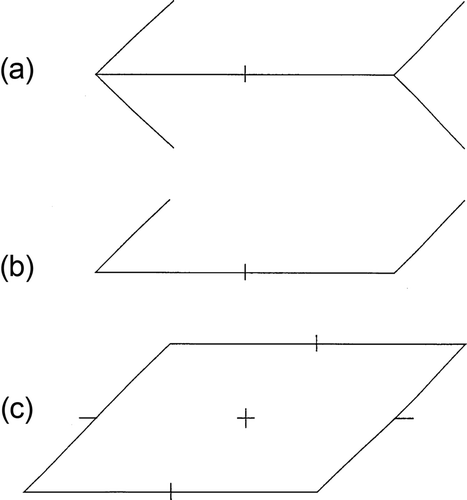
The conventional form of the Poggendorff figure in which the two collinear oblique lines appear to be misaligned is shown in . As with the Müller-Lyer figure there are numerous variants of the original figure, two of which are of particular relevance here. is an elaboration of , in which the collinear oblique lines are positioned between pairs of parallels. is a version of the co-called “corner Poggendorff” first reported in a circular figure by Judd (Citation1899), rediscovered by Greene (Citation1988) in a right angle figure and investigated in detail by Ninio and O'Regan (Citation1999). The difference between this figure and that in is that the oblique collinear lines are positioned between pairs of lines that are at right angles rather than parallel. As can be seen, whereas the collinear oblique lines in appear to be misaligned, those in appear to be at different angles. That is, in both figures the lines appear to be misaligned in different ways. The reason for this is shown in , in which short cross-lines are added at equal distances on either side of the points of intersection between oblique and parallel lines. Inspection, however, shows that, as in , the apparent distances in both figures are consistently less in the acute angles formed by the intersections than in the obtuse-angles. Because the locations of the apparently longer and long distances along one parallel are in the opposite positions along the other, it is to be expected that each oblique line will appear to be slightly rotated. That this is so is evidenced by the perceived misalignments in both figures. In these terms, the stimulus condition for apparent misalignment is the same as that in the Müller-Lyer figures; the difference in apparent extent of equal physical extents in acute and obtuse angles.
Figure 4. (a) A version of the Poggendorff figure in which the aligned oblique lines are enclosed between pairs of vertical parallels. (b) A version of the “corner Poggendorff’ figure in which the aligned oblique lines are enclosed between pairs of vertical and horizontal parallels
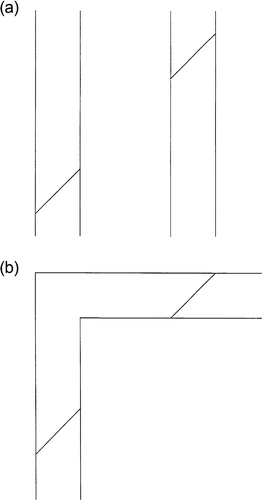
Figure 5. The (a) Poggendorff and (b) “corner Poggendorff” figures in which equal distances on both sides of the points of intersection of the oblique lines with the parallel lines are marked by short cross-lines to show the differences in apparent distances in the acute and obtuse angles
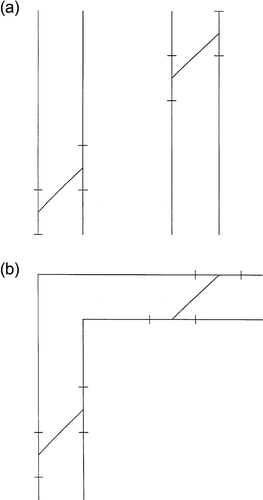
Additional support for this proposition is provided by an alternative figure first reported by Day, Stecher, and Parker (Citation1993), and Day and Parker-Halford (Citation1994), consisting of two parallelograms obliquely arranged so the oblique lines (or the edges of solid figures) are collinear, as shown in . The two parallelograms are the same as that shown in , in which the equal extents between midpoints and apexes of angles are the same but appear less toward the acute angles than toward the obtuse angles. In the critical differences are those at the vertical ends. As is evident in the enlarged in which the midpoints of the ends are again marked by short cross-lines, apparent distance toward the acute-angle corners appears shorter than the equal distance toward the obtuse-angle corners. Because the position of the apparently long and short sections at one end is reversed at the other end, it follows that each of the parallelogram components will appear to be slightly rotated upward at their lower ends and downward at their upper ends, with consequent apparent misalignment of their oblique collinear lines.
Figure 6. (a) Alternative version of the Poggendorff figure in which the oblique collinear lines of the parallelograms appear to be misaligned. (b) Enlargement of one parallelogram in which the short cross-lines mark the midpoints of the vertical lines
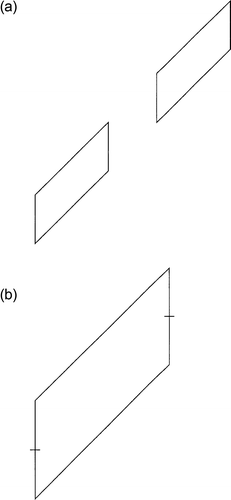
A Zöllner figure consisting of three parallel vertical lines each intersected by short oblique parallel lines oriented at 45° in opposite directions is shown in . The immediate impression is of two parallel vertical lines with a slightly tilted line between, such that the left and central lines appear to converge from below to above, and the right and central lines to do so from above to below. As with the Müller-Lyer and Poggendorff figures, the illusion occurs in a variety of figures (Coren & Girgus, Citation1978; Robinson, Citation1972; Wallace & Crampin, Citation1969). Incidentally, Boring (Citation1942) referred to the Zöllner illusion as “a dramatic elaboration of the principle involved in the Poggendorff illusion” but failed clearly to identify the principle. Careful reading of his comments suggests that the term “principle” refers simply to the phenomenon of apparent misalignment common to both figures.
Figure 7. (a) Reduced form of the Zöllner figure in which the left and right vertical parallels appear to be slightly non-parallel with the vertical parallel between them. (b) Enlargement of the units in (a) to show the difference in the apparent distances in the acute and obtuse angles formed by the oblique and vertical lines
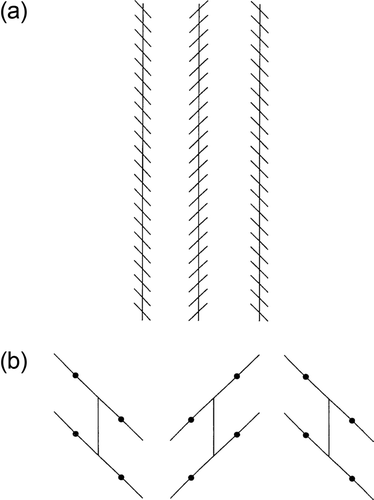
The Zöllner illusion can also be accounted for in terms of the greater apparent length of lines meeting to form obtuse angles compared with those of the same length meeting to form acute angles, as shown in the enlargements in . Thus between each pair of oblique parallel lines the vertical line forms essentially the same units as that in . Considering first the pair on the left, the vertical line intersects the lower oblique such that the distance to the dot in the obtuse angle on the right appears greater than that in the acute angle on the left. This difference in apparent extent is reversed in the intersection of the vertical with upper oblique; the distance to the dot on the left appears greater than that of equal length to the dot on the right. In consequence, the vertical line appears slightly tilted to the left in essentially the same manner as that in the Poggendorff figure in . In this case, however, the slightly leftward tilt is repeated from below to above in each of the pairs of oblique lines, so that the extended vertical appears tilted. The same effect in the same direction from below to above occurs with the repeated oblique units on the right in . As also shown in the enlargement, however, whereas the same apparent tilt of the vertical line occurs between the pair of oblique lines in the central component in , it is in the opposite direction to that on the left and right. Thus from below to above the extended vertical line appears to be tilted leftward and therefore non-parallel with those on the right and left of it. In support of this explanation of the Zöllner illusion in terms of an additive effect of opposing directions of pairs of short oblique lines, essentially the same effect can be seen in , in which each of the short oblique lines is slightly tilted in consequence of the acute and obtuse angles formed at the intersection with the extended vertical and horizontal parallels. Inspection will show that essentially the same conditions as those in prevail between pairs of lines to generate the slightly different overall orientations of the short collinear lines.
Critical role of oblique intersections
It is clear from the present and earlier observations that there is a group of geometrical illusions that are attributable to oblique intersections between straight lines, a condition that is present in a wide range of figures in addition to the three well-known and frequently reproduced figures considered here. Others include the Hering (Citation1861), Wundt (Citation1898) and Orbison (Citation1939) effects reproduced and discussed in the monographs of Robinson (Citation1972) and Coren and Girgus (Citation1978). But although oblique intersections and their apparent difference in acute- and obtuse-angle extents are strongly implicated, the perceptual process that these stimulus conditions engender is not. In what follows it is proposed that the process is the correlation between the length of the lines forming a stimulus figure and the overall size of the figures themselves.
After drawing attention to the apparently greater length of lines forming obtuse angles compared with those of the same length forming acute angles as shown here in , Müller-Lyer (Citation1889) went on to point out and demonstrate that this difference is also evident in other commonplace geometrical figures. For example, the lines of an equilateral triangle in which all the angles are acute appear shorter than those of the same length in a pentagon in which all the angles are obtuse. Day (Citation2006) extended these observations by showing that lines, also of the same length, forming a square appear intermediate in length between those of the triangle and pentagon and, moreover, that the same differences are evident in the equal dimensions of other figures . In consequence it was concluded that the apparent length of lines forming a figure is determined by the overall size of the figure of which they are integral parts. In this regard, given that the overall size of the obtuse angles such as those in is greater than that of the acute angles, the constituent lines will appear to be longer. In summary, the Müller-Lyer, Poggendorff and Zöllner illusions are attributed to the difference in the apparent lengths of lines of the same physical lengths forming obtuse and acute angles that are markedly different in their overall dimensions.
In conclusion, the main point to emerge from this analysis of the Müller-Lyer, Poggendorff and Zöllner illusions is that although they are very different in regard to the stimulus properties in which the illusion is manifest, those of apparent length, alignment and parallelism, respectively, all three effects arise from the same stimulus condition, that of oblique intersections. This hitherto unrecognised commonality raises the question of whether there are other illusions that, although different in phenomenonological terms, are nevertheless due to a common stimulus property. In the interest of a closer understanding of the true basis of illusory perception this issue warrants further empirical and theoretical consideration.
Acknowledgement
The advice and assistance of David Walsh in the preparation of the figures are gratefully acknowledged.
References
- Boring, E. C., 1942. Sensation and perception in the history of experimental psychology. New York: Appleton-Century-Crofts; 1942.
- Coren, S., and Girgus, J. S., 1978. Seeing is deceiving: The psychology of visual illusions. Hillsdale, NJ: Lawrence Erlbaum; 1978.
- Day, R. H., 1974. The Poggendorff illusion: Apparent displacement and rotation of the oblique lines, Australian Journal of Psychology 26 (1974), pp. 49–59.
- Day, R. H., 1976. Apparent length of the arms of acute and obtuse angles, and the components of the Müller-Lyer illusion, Australian Journal of Psychology 28 (1976), pp. 137–148.
- Day, R. H., 2006. Two principles of perception revealed by geometrical illusions, Australian Journal of Psychology 58 (2006), pp. 123–128.
- Day, R. H., and Parker-Halford, A. L., 1994. On apparent misalignment of collinear edges and boundaries, Perception and Psychophysics 56 (1994), pp. 517–524.
- Day, R. H., Stecher, E. J., and Parker, A. L., 1993. The effect of edge orientation and movement direction on the apparent misalignment of collinear bars, Perception and Psychophysics 53 (1993), pp. 642–647.
- Greene, E., 1988. The corner Poggendorff, Perception 17 (1988), pp. 65–70.
- Hering, E., 1861. Beitrage zur Psychologie. Leipzig: Engleman; 1861.
- Judd, C. H., 1899. A study of geometrical illusions, Psychological Review 6 (1899), pp. 241–261.
- Müller-Lyer, F. C., 1889. Optische Urteilstauschungen, Dubois-Reymond's Archive für Anatomie und Physiologie Supplement band (1889), pp. 261–267.
- Ninio, J., and O'Regan, J. K., 1999. Characterisation of the misalignment and misangulation components in the Poggendorff and corner-Poggendorff illusions, Perception 28 (1999), pp. 949–964.
- Orbison, W. D., 1939. Shape as a function of the visual field, American Journal of Psychology 52 (1939), pp. 31–45.
- Robinson, J. O., 1972. The psychology of visual illusion. London: Hutchinson; 1972.
- Wallace, G. K., and Crampin, D. J., 1969. The effects of background density on the Zöllner illusion, Vision Research 9 (1969), pp. 167–177.
- Wundt, W., 1898. Die geometrisch-optischen Täuschungen, Akadamieder der Saechs Wissenschaften 24 (1898), pp. 53–178.
- Zöllner, J. K. F., 1860. Ueber eine neue Art von Pseudoskopie und ihre Beziehung zu den von Plateau und opel beschriebenen Bewegungsphaenomenon, Annalen der Physik XX (1860), pp. 500–525.
